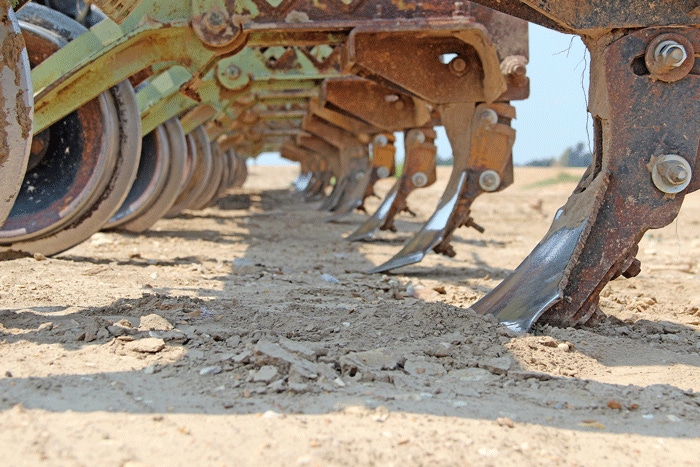
Farm business good in North Carolina, but challenges remain
• Over the past decade North Carolina has lost more agricultural acres to industrial, military and residential buildup than any other state, most recently surpassing California.• Despite the loss of farmland, the state’s farmers and agribusiness industry, along with staunch support from a small cadre of politicians, have built a $71 billion industry that surpasses the next closest — military and tourism — combined.
August 8, 2012

Agriculture is booming in North Carolina and Commissioner of Agriculture Steve Troxler is proud to point that out.
But today’s successes often hide some of the critical challenges facing the state’s largest industry in the future.
Over the past decade North Carolina has lost more agricultural acres to industrial, military and residential buildup than any other state, most recently surpassing California. Despite the loss of farmland, the state’s farmers and agribusiness industry, along with staunch support from a small cadre of politicians, like Troxler, have built a $71 billion industry that surpasses the next closest — military and tourism — combined.
Troxler says revitalizing North Carolina’s rural economy with an influx of agriculture-based industries is critical to the continued growth and prosperity of the state’s largest industry. Like most states, the infrastructure of agriculture in North Carolina is aging.
From the Land-Grant system of agricultural teaching, research and Extension to aging storage, processing, transportation and port facilities, the system needs a shot of energy and strong support from the state’s elected officials, Troxler says.
The loss of farmland in itself is a tough obstacle to overcome in order to keep North Carolina’s agriculture industry booming. Troxler points out that it’s not just the quantity of farm land that is being taken out of agricultural production that threatens agriculture economic growth in the future. It’s the quality of the farm land the state is losing that is of most concern.
Soil that is good for raising farm crops is also the most desirable, from a structural standpoint, for building residential housing and industrial buildings. “If we were losing poor crop land that would be a problem, but losing high quality farm land is a much bigger problem,” the North Carolina Ag Commissioner adds.
The Commissioner is not opposed to progress, even if it means bringing more people (estimated to be 5 million more people in North Carolina in 2012 versus 2011), far from it. He is concerned about replacing highly productive farm land, or more precisely, the food this land produces.
Research is the answer
Research is the best answer — we simply have to improve technology enough to allow farmers to grow more crops per acre. That’s nothing new, but Troxler says few people in North Carolina or anywhere else in the U.S. seem to understand that for every dollar invested in agricultural research, the return on investment is $19.
“I’m a farmer and a businessman. If you come to me with an offer that will allow me a 19 to 1 return on investment, I’m going to take that deal every day. Yet, I’m amazed at how hard that deal is to sell to the general public, and more so, to politicians with no agricultural background,” Troxler says.
In North Carolina and Virginia, both grain deficient states, because of huge livestock industries there, the 10-year average yield of corn is actually going down.
Despite significant technological breakthroughs during that time period, research has not been able to keep pace with weather-related yield losses.
Research can help, but not completely overcome the reality that more and more crops are being planted on marginal land with marginal yield capabilities.
Troxler says don’t blame downward trends in grain production on the weather. “It’s always too hot, too cold, too wet or too dry to grow crops,” he quips.
Farmers figured out a long time ago, though not always to their best economic advantage, that weather is a constant — it constantly changes. Helping farmers change with these constantly changing weather conditions is going to be critical to continued growth of the agriculture industry in North Carolina, he adds.
In April of 2011, tornadoes of historic number and ferocity criss-crossed the southern third of North Carolina, ripping up farmland and depositing unbelievable amounts of debris, some of which farmers are still coping with in the 2012 planting season.
Though most growers have recovered from the physical losses from the storms, many are still trying to cope with their financial losses.
“We found out that FEMA was not, and is not equipped to deal with agriculture. That’s not due to a lack of concern, but the agency just doesn’t have the resources or direction it needs to help farmers recover their losses from catastrophic weather,” Troxler says.
Farmers have the highest prices anyone can remember for their crops, he adds. But, they also have the highest prices ever for the inputs it takes to grow these high value crops. As a farmer and a businessman, I can tell you that combination means one thing — higher risks.
“Last year, we had a minimal hurricane, when Irene brushed the North Carolina coast. The losses farmers took from this storm were much greater just because the value of their crops was much greater and the value of the inputs they used to grow their crops was much greater.
Weather ramps up risk
“Whether it be hurricanes, tornadoes or the extreme drought we’ve seen in recent years in North Carolina, weather significantly ramps up the risks and the pressure on farmers.
“Finding ways to decrease economic risks to farmers and improving the productivity of producing crops and livestock go hand-in-hand with helping farmers feed the world in the future,” Troxler says.
One of the keys to revitalizing the rural economies of Southeastern states is the export market.
Troxler has worked tirelessly in helping North Carolina farmers build a booming agricultural export business. No question that increasing grain, cotton, peanut, sweet potato and tobacco exports will bring more dollars to rural areas of the state, but some contend exporting grain from a livestock rich and grain poor state like North Carolina isn’t a good thing.
Troxler says a truly ‘free’ market will benefit both livestock and grain producers. It will allow both to compete globally to sell their products.
To help offset the loss of exported grain, the North Carolina Department of Agriculture and some large grain buyers in the area are promoting production of grain sorghum and other alternative crops to corn, soybeans and wheat that can be used in livestock rations.
Growing grain sorghum may be one of those upcoming success stories for agriculture. Murphy-Brown, a large grain buyer in the Tar Heel state, has made a concerted effort to increase grain sorghum production in the Carolinas. “Before we go too far in promoting grain sorghum, we have to be sure we have a market for the crop, and we are making great strides in doing just that,” Troxler says.
Troxler says he has no doubts that export of North Carolina-grown agricultural products will be a good thing for farmers and agribusiness leaders in the state. He does, however, have some doubts about the infrastructure needed to take full advantage of export opportunities.
“Right now the old adage ‘we’ve missed the boat’ applies to North Carolina. Too much of the farm crops grown in North Carolina are being shipped out of ports in other states, because of a lack port facilities.
In addition to upgrading our ports, we simply must improve our transportation, processing and storage facilities in rural areas of the state,” the Commissioner says.
“The farm business is good in North Carolina, but working together, we have a real opportunity to make it even better in the future,” Troxler adds.
About the Author(s)
You May Also Like





